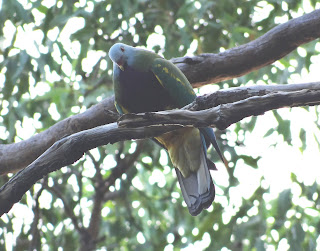Today I paddled the Mary River in the Sunshine Coast hinterland in two stretches. I was dropped off at Kenilworth Homestead early morning, travelling 14km to Pickering Bridge for lunch, then paddled a further 11km to Walker Road. This nice patch of lowland rainforest along the river was an unexpected find.
Bunya Pine on the left, Hoop Pine on the right.
Restless Flycatcher was one of the commoner passerines in riverside vegetation.
Azure Kingfisher always looking good.
Little Pied Cormorant was plentiful.
A stretch of the river with Kenilworth Bluff in the background. The Mary is the river that would have been flooded by the Traveston Dam, a state government proposal which was canned by the federal Labor Government on environmental grounds.
Following another solid wet season, the river was flowing strongly, with frequent stretches of rapids, sometimes a tad intimidating.
A single Platypus put in an appearance; I expected to see more.
Two female Red-backed Fairy-wrens were nice in riverside grasses.
Along with this Tawny Grassbird.
I was surprised to find two pairs of vocal White-eared Monarchs in late-May, indicating that this species is indeed resident in south-east Queensland year-round; it had long thought to be a summer migrant, like the Black-faced and Spectacled Monarchs. The White-eared Monarchs were in narrow strips of riverside vegetation consisting primarily of introduced Camphor laurel trees.
Black-fronted Dotterel was regular on pebbly banks.
The kayak beached on a sandbar in the river.
Just before the end, one of the many stretches of rapids proved a bit too much. I was unable to avoid a protruding branch over the rapids and was knocked out of the boat as it was upturned. Fortunately my camera, I-Pod etc were in a waterproof bag; I salvaged everything except an old cardigan and my dignity.
Bunya Pine on the left, Hoop Pine on the right.
Restless Flycatcher was one of the commoner passerines in riverside vegetation.
Azure Kingfisher always looking good.
Little Pied Cormorant was plentiful.
A stretch of the river with Kenilworth Bluff in the background. The Mary is the river that would have been flooded by the Traveston Dam, a state government proposal which was canned by the federal Labor Government on environmental grounds.
Following another solid wet season, the river was flowing strongly, with frequent stretches of rapids, sometimes a tad intimidating.
A single Platypus put in an appearance; I expected to see more.
Two female Red-backed Fairy-wrens were nice in riverside grasses.
Along with this Tawny Grassbird.
I was surprised to find two pairs of vocal White-eared Monarchs in late-May, indicating that this species is indeed resident in south-east Queensland year-round; it had long thought to be a summer migrant, like the Black-faced and Spectacled Monarchs. The White-eared Monarchs were in narrow strips of riverside vegetation consisting primarily of introduced Camphor laurel trees.
Black-fronted Dotterel was regular on pebbly banks.
The kayak beached on a sandbar in the river.
Just before the end, one of the many stretches of rapids proved a bit too much. I was unable to avoid a protruding branch over the rapids and was knocked out of the boat as it was upturned. Fortunately my camera, I-Pod etc were in a waterproof bag; I salvaged everything except an old cardigan and my dignity.





















































_Cairns_Qld_Feb_2008.jpg)